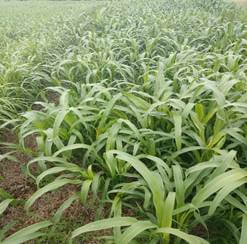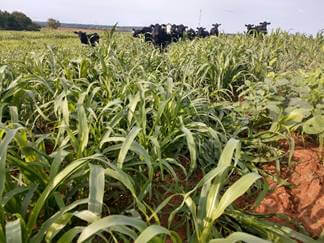Paul Beck, Oklahoma State University State Extension Beef Nutrition Specialist
Drought has impacted pasture forage production and hay yields across the region. Many producers are faced with the choice between selling cows now or feeding up their already limited hay supply early. Late last week areas across North Texas, Northern Oklahoma and into Kansas and the Mid-South got nice rains which can rejuvenate drought-stricken pastures and provide some relief from pressure to start feeding hay. This rain also provides the opportunity to plant warm-season annuals into crop fields for fall pasture.
Warm-season annuals are often thought of as emergency grazing and hay crops when late spring and early summer hay harvests are lacking. Annual forage crops such as millets, sudangrass and sorghum-sudangrass hybrids or legumes like cow peas or mung beans are usually planted in the late spring or early summer for mid to late summer harvest. Recent research has investigated using annual forages in novel ways to further extend grazing seasons. In the Southeast and Southern Great Plains, late summer plantings of warm-season annuals have been used to fill the gaps in fall forage production.
Annual grasses including sorghum/sudangrass, Pearl millet, browntop millet, and corn were planted in late August of 2018, when these were harvested in October 42 days later yields ranged from 2,500 pounds of dry matter per acre for browntop millet and a VNS corn to over 3,300 pounds of dry matter per acre for sorghum/sudangrass, Pearl millet, and a brown midrib grazing corn variety. These forages were 16 to 18% crude protein and 60 to 65% total digestible nutrients at harvest in October. Following a frost in late November, these forages were still 12 to 15% crude protein and 61 to 65% TDN for all but browntop millet that was only 51% TDN.
Grazing of millets, sudangrass, and sorghums should be withheld until they are 18 to 36 inches tall and rotations should be timed to leave 6 to 8 inches of stubble height to enhance regrowth potential. Grazing can occur as early as 4 weeks post planting, but their rapid growth makes ideal management challenging.
Steers grazing millet and a cover crop forage blend in the late summer and fall gained over 2 pounds per day in tests in Central Oklahoma, showing these forages can be an option for high quality pasture in the gap between summer grass and fall wheat pasture.
These pastures were planted the first of August and were grazed starting on September 11, 40-days after planting.


This year high feed and grain prices limit our ability to feed our way out of a drought. Annual forages offer many advantages in designing systems to extend grazing seasons in all environments. Annual forages are generally higher in nutritive value than perennials and plantings can be timed to fill gaps in availability of the dominant perennial forages in the local environment.
Dr. Alex Rocateli, OSU Extension Forage Systems Specialist, gives guidance for producers wanting to use corn as a forage on SunUp TV from July 23, 2022.
